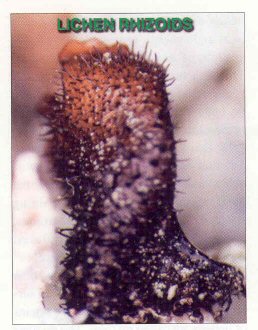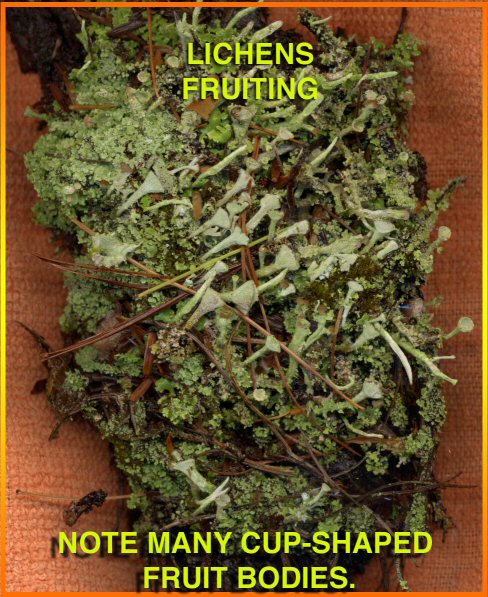

By Dr. Alex Shigo
WARNING! Learning about lichens can become addictive!

Customers often ask about things on and near their trees. If you know, fine, tell them. If you do not know, say you will find out soon and get back to them. The more you know the better for your credentials, and the next job.
What are lichens?
Lichens are organisms made up of fungi - mycobionts - and photosynthetic algae, cyanobacteria, or both, - photobionts. The connections between the organisms are so highly ordered that the organisms repeat. There are at least 30,000 known species of lichens world- wide. Lichens are micro ecosystems. The body is called a Thallus. They come in many shapes, sizes and colors.
The algae and cyanobacteria (old name, blue-green algae) contain chlorophyll that traps the light energy from the sun, and passes some of it on to the mycobionts. The fungi have haustoria, which are finger-like projections that penetrate each cell of the photobiont. Most cyanobacteria fix nitrogen, which means they have an enzyme system that converts atmospheric nitrogen to ammonia and ammonium ions. The ammonium ions then act as building blocks for many other essential chemical compounds, especially proteins that build mass of an organism, and enzymes that make processes move in a highly ordered way.
Where do lichens grow?
Lichens can be found on many different surfaces, from rocks, soils, trees, dead materials, and even old rusting machines, especially abandoned cars. They often appear as thin or thick paint blotches on tree trunks. They seem to be every place where others could not or would not grow. They grow under conditions that would be extremely difficult, or impossible, for other organisms. For example, they grow far beyond the tree lines, and are major energy sources for many other land organisms, especially large animals like reindeer and caribou.

Do lichens harm trees?
If lichens cause disease of trees, can they also cause diseases of rocks? Silly, YES! There are no data that shows lichens cause tree or rock diseases. Yet, this does not stop some people. Believe it or not, some people charge uninformed customers to remove lichens. Sad, indeed!
The beard-moss lichen can hang several meters from trees, usually trees such
as species growing in very cold climates near the tree lines. It is often
confused with Spanish moss. Spanish moss is a flowering plant, and pine-
apples are in the family. Pineapples are very far removed from lichens.
Whether the lichens help the spruce trees, or limit photosynthesis, nobody
knows. And, as with lichens, some people charge customers to remove
Spanish and ball moss from trees that grow in warm climates.
I hope you are beginning to understand now why people need to know something
about lichens, and other things on trees. Lichenology needs much attention
from research.
Symbiosis or controlled parasitism?
The lichen experts are still not sure whether the mycobionts enslave the photobionts, or whether both benefit all, the time as symbiosis, leading to synergy where all partners benefit far beyond their abilities if growing alone. I'm no lichen expert, but I believe the latter is true, and synergy is at work.
Lichens are masters of dormancy. They can survive for long periods under very harsh conditions. When conditions do become favorable, they are able to respond rapidly, and grow rapidly. Consider that they grow where very few to no other organisms can grow. In favorable places they can be so aggressive that other organisms have difficulty gaining space. They are abundant in the tropics, and dry deserts, and very cold places. Again, they seem to be everywhere!
Many experts think lichens were some of the first organisms to colonize land surfaces on young earth. The root-like organs of lichens are called rhizines. The rhizines penetrate rocks and aid decomposition. Lichens also produce acids and other chemicals that break down rocks and other materials. The materials are also used to support growth of the lichens. In a sense, the rocks are long-term or very-slow-release fertilizers. The rock decomposition minerals start the formation of soils. As lichens die they add to the organic material to the soil. Again, for these reasons, I believe they are synergistic, and one partner is not enslaving the other partner. Many people believe that so-called higher organisms became higher organisms as they connected with many other organisms (mitochondria?). Maybe the lichens got the message first. Who knows?

Are lichens of any value?
The wool for the original Harris Tweed coats was dyed using materials from lichens. The spread of radioactive materials from Chernobyl was traced using lichens because they concentrated the radioactive contaminants in their parts, and the lichens were then eaten by large animals. Lichens are used for food in many parts of the world, especially in Asia. Their extracts are used for per- fumes. They are very sensitive to pollutants, and are used to detect their presence. If lichens die suddenly, a real pollution problem is on the way. New medicines are coming from lichens. Some lichens are known to produce antibiotics. Many countries are now keeping a close eye on lichen collectors, and forbidding the export of lichens.
I have only touched the surface of this subject. It needs much more attention. But, be careful, and remember my warning at the beginning! Go out and connect with some lichens; touch them, and don't forget on the way to TOUCH TREES!
 Lichens growing on an old, rotted log.
Lichens growing on an old, rotted log.
“An author,
lecturer and consultant, Dr. Shigo started
Shigo and Trees, Associates
twenty
years ago after retirement from the U.S. Forest Service.”
Reproduced with permission of Tree Care Industry and Dr. Alex L. Shigo.
The article was published in Volume XIV, Number 12-December 2003 of TCI.
This site is dedicated to the remembrance of Robert Felix who for many years
worked very hard for the improvement of the tree care industry: 1934-1996.
Dictionary MAIN
PAGE
Text & Graphics Copyright © 2009
Keslick & Son Modern Arboriculture
Please report web site problems, comments and words of interest,
not found.
Contact